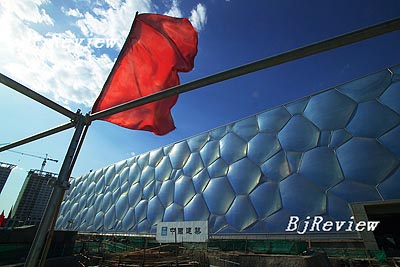
Driving along Beijing's fourth ring road, in the northern part of the city, a surreal bubble-like structure suddenly comes into view. It's a building like no other in Beijing, and probably the world. The city's National Aquatics Center, known as the Water Cube, will be an attraction for visitors to the city for decades to come, just to witness its strangeness.
The process that led to its creation began in July 2003, when Sydney-based architecture companies PTW Architects and Ove Arup, with the China State Construction and Engineering Corp. (CSCEC) and the CSCEC Shenzhen Design Institute won an international design competition to build the National Aquatics Center for the 2008 Beijing Olympics.
What they have created will ensure that the Water Cube, so named because of its shape and appearance, will be one of the most dramatic and exciting venues to feature sporting events during the Beijing Olympics in 2008 as well as one of the three centerpiece Olympic ventures.
John Pauline, a designer from PTW Architects and Chief Designer of the Water Cube, said that the seemingly improvised creation is the result of blending hi-tech with Eastern architectural beauty.
"In the process of designing, the question we discussed the most was how to absorb elements from Eastern architectual design in stadium construction and Chinese culture, especially when constructing a swimming stadium, which gave designers more room for creativity in outlook and function," Pauline said. He said their Chinese partners' emphasis on the traditional Chinese quadrangle courtyard shape had made an deep impression on him, and motivated him to try his hands at desiging a rectanglar building. "The final result is good."
The Arup/PTW design, playing on the geometry of water bubbles in a rectangular form, is specifically shaped to work in harmony with the elliptic main Olympic stadium, the National Stadium, designed by the Swiss architectural team of Herzog & de Meuron Architekten with the China Architecture Design and Research Group. The contrast between the buildings is also intended to reflect the ancient Chinese belief that heaven was circular and the earth was square.
In the early stages of design, PTW Architects reached an agreement with its Chinese partners that the main body of the National Aquatics Center should be transparent, which finally led to the proposal for the Water Cube.
"To arrive at the building's structural design, we reflected on all forms of water, including waves stirred by swimmers, to find an infinite image for this water theme," said Pauline.
During this process the designers settled on an image of soap bubbles. "All of the designers got excited when they found that soap bubbles arranged in an infinite array can give a random, organic appearance," said Pauline.
PTW's partner Ove Arup was given the task of generating a three-dimension model resembling soap bubbles, which became the steel frame of the Water Cube.
To bring the design to life, the individual bubbles were incorporated into membranes of ethylene-tetra-fluoro-ethylene (ETFE) and tailored like a sewing pattern. Entire sections were first pieced together and then put into place within the structure. The membrane was then inflated once it was in-situ and it will be continuously pumped thereafter.
It is the first time a membrane structure made from ETFE has been used in China. It is also the largest and most complicated membrane system in a single building project internationally. The feasibility of using ETFE came under attack during the design process but the designers insisted that it is strong encough to meet the demanding requirements of a swimming stadium.
| 